Assessment of Rooftop Solar Power Generation to Meet Residential Loads in the City of Neom, Saudi Arabia
Abstract
:1. Introduction
- Investigate the technical and economic viability of rooftop PV systems with battery storage for different types of domestic buildings.
- Identify the optimum PV panel size and battery capacity to maximize reduction in demand from the grid.
- Identify the optimum orientation of rooftop PV panels to maximize electricity generation.
2. Literature Review
2.1. Theoretical Concept of Net Zero Energy Building
2.1.1. Net Zero Energy Building
2.1.2. Building Energy Efficiency
2.2. Economic Viability of Rooftop Solar Energy
2.2.1. Factors Affecting PV Solar Panel Generation
2.2.2. Domestic Load Profile
2.2.3. Techno-Economic Feasibility of Rooftop Solar PV
2.3. KSA Context
2.3.1. Building Energy Demand
2.3.2. Building Regulations
3. Methodology
3.1. Homer Pro Software
3.2. Design of Solar PV System
3.2.1. System Configuration
3.2.2. PV Orientation and Battery Storage
3.3. KSA Load Profile and Type of Data
3.4. Geographical Location Parameters
3.4.1. Global Horizontal Irradiance (GHI)
3.4.2. Air Temperature
3.5. Economic Parameters
- Cann: the annualized cost.
- i: the annual real discount rate (%).
- Nproj: project lifetime (year).
- CRF (i, Nproj): capital recovery factor.
- Eserved: total electrical load served (kWh/year).
- Ci,ref = nominal annual cash flow for base (grid) system,
- Ci = nominal annual cash flow for IES,
- Rproj = project lifetime (year),
- Ccap = capital cost of the IES, and
- Ccap,ref = capital cost of the base (grid) system.
4. Results
4.1. Economic Analysis
4.2. Technical Analysis
4.2.1. Optimum PV System Size and Battery Storage Capacity
4.2.2. Assessment of PV Orientation
4.2.3. Energy Production
4.3. Sensitivity Analysis
5. Discussion
5.1. Economic Aspects
5.2. Technical Aspects
5.3. Limitations of the Investigation
6. Conclusions
Author Contributions
Funding
Institutional Review Board Statement
Informed Consent Statement
Data Availability Statement
Acknowledgments
Conflicts of Interest
Nomenclature
| KSA | Kingdom of Saudi Arabia |
| GW | Gigawatt |
| MW | Megawatt |
| kW | Kilowatt |
| SEC | Saudi Electricity Company |
| PV | Photovoltaic |
| GHI | Global Horizon Irradiance |
| NREL | National Renewable Energy Laboratory |
| CO2 | Carbon dioxide |
| HVAC | Heating, ventilation, and air conditioning |
| kWh | Kilowatt hour |
| SDG | Sustainable development goal |
| € | Euro |
| NPV | Net present value |
| DPBP | Discount payback period |
| IES | Integrated energy system |
| SAMA | Saudi Arabian Monetary Authority |
| DNI | Direct normal irradiation |
| IRENA | International Renewable Energy Agency |
| Homer Pro | Hybrid Optimization of Multiple Energy Resources |
| GCC | Gulf Cooperation Council |
| °C | Degree Celsius |
| AC | Air conditioning |
| NASA | National Aeronautics and Space Administration |
| ECRA | Electricity and Co-Generation Regulatory Authority |
| DC | Direct current |
| VAT | Value added tax |
| GATOR-GCMOM | Gas, Aerosol, Transport, Radiation, GeneralCirculation, Mesoscale, and Ocean Model |
| AC | Alternative current |
| $ | US dollar |
| NZEB | Net zero energy building |
| LCOE | Levelized cost of energy |
| ROI | Return on investment |
| IRR | Internal rate of return |
| PBP | Payback period |
| NPC | Net present cost |
References
- Shaahid, S.M. Economic feasibility of decentralized hybrid photovoltaic-diesel technology in Saudi Arabia: A way forward for sustainable coastal development. Therm. Sci. 2017, 21, 745–756. [Google Scholar] [CrossRef] [Green Version]
- Felimban, A.; Prieto, A.; Knaack, U.; Klein, T.; Qaffas, Y. Assessment of Current Energy Consumption in Residential Buildings in Jeddah, Saudi Arabia. Buildings 2019, 9, 163. [Google Scholar] [CrossRef] [Green Version]
- Asif, M. Growth and sustainability trends in the buildings sector in the GCC region with particular reference to the KSA and UAE. Renew. Sustain. Energy Rev. 2016, 55, 1267–1273. [Google Scholar] [CrossRef]
- Tsalikis, G.; Martinopoulos, G. Solar energy systems potential for nearly net zero energy residential buildings. Sol. Energy 2015, 115, 743–756. [Google Scholar] [CrossRef]
- Gielen, D.; Boshell, F.; Saygin, D.; Bazilian, M.D.; Wagner, N.; Gorini, R. The role of renewable energy in the global energy transformation. Energy Strategy Rev. 2019, 24, 38–50. [Google Scholar] [CrossRef]
- Albalawi, H.; Eisa, A.; Aggoune, E.H.M. Energy Warehouse—A New Concept for NEOM Mega Project. In Proceedings of the 2019 IEEE Jordan International Joint Conference on Electrical Engineering and Information Technology (JEEIT), Amman, Jordan, 9–11 April 2019; pp. 215–221. [Google Scholar] [CrossRef]
- Government of Saudi Arabia. Vison 2030 Kingdom of Saudi Arabia; Report 1–85; Government of Saudi Arabia: Riyadh, Saudi Arabia, 2016.
- Ali, F.; Ahmar, M.; Jiang, Y.; AlAhmad, M. A techno-economic assessment of hybrid energy systems in rural Pakistan. Energy 2021, 215. [Google Scholar] [CrossRef]
- Kosmadakis, I.E.; Elmasides, C.; Koulinas, G.; Tsagarakis, K.P. Energy unit cost assessment of six photovoltaic-battery configurations. Renew. Energy 2021, 173, 24–41. [Google Scholar] [CrossRef]
- Li, C.; Zhou, D.; Zheng, Y. Techno-economic comparative study of grid-connected PV power systems in five climate zones, China. Energy 2018, 165, 1352–1369. [Google Scholar] [CrossRef]
- Liu, J.; Wang, M.; Peng, J.; Chen, X.; Cao, S.; Yang, H. Techno-economic design optimization of hybrid renewable energy applications for high-rise residential buildings. Energy Convers. Manag. 2020, 213. [Google Scholar] [CrossRef]
- Akinsipe, O.C.; Moya, D.; Kaparaju, P. Design and economic analysis of off-grid solar PV system in Jos-Nigeria. J. Clean. Prod. 2021, 287. [Google Scholar] [CrossRef]
- Ghafoor, A.; Munir, A. Design and economics analysis of an off-grid PV system for household electrification. Renew. Sustain. Energy Rev. 2015, 42, 496–502. [Google Scholar] [CrossRef]
- Kosmadakis, I.E.; Elmasides, C. A sizing method for PV–battery–generator systems for off-grid applications based on the LCOE. Energies 2021, 14, 1988. [Google Scholar] [CrossRef]
- Ridha, H.M.; Gomes, C.; Hizam, H.; Ahmadipour, M.; Heidari, A.A.; Chen, H. Multi-objective optimization and multi-criteria decision-making methods for optimal design of standalone photovoltaic system: A comprehensive review. Renew. Sustain. Energy Rev. 2021, 135. [Google Scholar] [CrossRef]
- Arif, M.T.; Oo, A.M.T. Net-zero emission residential building in temperate weather condition. EDP Sci. 2017, 30. [Google Scholar] [CrossRef] [Green Version]
- Ristvej, J.; Lacinák, M.; Ondrejka, R. On Smart City and Safe City Concepts. Mob. Networks Appl. 2020. [Google Scholar] [CrossRef] [Green Version]
- Krarti, M.; Ihm, P. Evaluation of net-zero energy residential buildings in the MENA region. Sustain. Cities Soc. 2016, 22, 116–125. [Google Scholar] [CrossRef]
- Awan, A.B.; Zubair, M.; Praveen, R.P.; Abokhalil, A.G. Solar energy resource analysis and evaluation of photovoltaic system performance in various regions of Saudi Arabia. Sustainability 2018, 10, 1129. [Google Scholar] [CrossRef] [Green Version]
- Gagnon, P.; Margolis, R.; Melius, J.; Phillips, C.; Elmore, R. Estimating rooftop solar technical potential across the US using a combination of GIS-based methods, lidar data, and statistical modeling. Environ. Res. Lett. 2018, 13. [Google Scholar] [CrossRef]
- Samani, P.; Mendes, A.; Leal, V.; Correia, N. Pre-fabricated, environmentally friendly and energy self-sufficient single-family house in Kenya. J. Clean. Prod. 2017, 142, 2100–2113. [Google Scholar] [CrossRef]
- Calabrò, E. An Algorithm to Determine the Optimum Tilt Angle of. J. Renew. Energy 2013, 2013, 12. [Google Scholar]
- Guo, M.; Zang, H.; Gao, S.; Chen, T.; Xiao, J.; Cheng, L.; Wei, Z.; Sun, G. Optimal tilt angle and orientation of photovoltaic modules using HS algorithm in different climates of China. Appl. Sci. 2017, 7, 1028. [Google Scholar] [CrossRef] [Green Version]
- Al Garni, H.Z.; Awasthi, A.; Wright, D. Optimal orientation angles for maximizing energy yield for solar PV in Saudi Arabia. Renew. Energy 2019, 133, 538–550. [Google Scholar] [CrossRef]
- Kaddoura, T.O.; Ramli, M.A.M.; Al-Turki, Y.A. On the estimation of the optimum tilt angle of PV panel in Saudi Arabia. Renew. Sustain. Energy Rev. 2016, 65, 626–634. [Google Scholar] [CrossRef]
- Jacobson, M.Z.; Jadhav, V. World estimates of PV optimal tilt angles and ratios of sunlight incident upon tilted and tracked PV panels relative to horizontal panels. Sol. Energy 2018, 169, 55–66. [Google Scholar] [CrossRef]
- Hennings, W.; Stenzel, P.; Pflugradt, N. Performance of a photovoltaic plus battery home system with load profile scenarios changing over the system life. Energy Procedia 2017, 142, 3252–3257. [Google Scholar] [CrossRef]
- Alrawi, O.; Bayram, I.S.; Al-Ghamdi, S.G.; Koc, M. High-resolution household load profiling and evaluation of rooftop PV systems in selected houses in Qatar. Energies 2019, 12, 3876. [Google Scholar] [CrossRef] [Green Version]
- Awan, A.B.; Zubair, M.; Praveen, R.P.; Bhatti, A.R. Design and comparative analysis of photovoltaic and parabolic trough based CSP plants. Sol. Energy 2019, 183, 551–565. [Google Scholar] [CrossRef]
- Vimpari, J.; Junnila, S. Estimating the diffusion of rooftop PVs: A real estate economics perspective. Energy 2019, 172, 1087–1097. [Google Scholar] [CrossRef]
- Mariaud, A.; Acha, S.; Ekins-Daukes, N.; Shah, N.; Markides, C.N. Integrated optimisation of photovoltaic and battery storage systems for UK commercial buildings. Appl. Energy 2017, 199, 466–478. [Google Scholar] [CrossRef]
- Hartner, M.; Mayr, D.; Kollmann, A.; Haas, R. Optimal sizing of residential PV-systems from a household and social cost perspective: A case study in Austria. Sol. Energy 2017, 141, 49–58. [Google Scholar] [CrossRef]
- Al-Badi, A.; AlMubarak, I. Growing energy demand in the GCC countries. Arab J. Basic Appl. Sci. 2019, 26, 488–496. [Google Scholar] [CrossRef] [Green Version]
- Ellabban, O.; Alassi, A. Integrated Economic Adoption Model for residential grid-connected photovoltaic systems: An Australian case study. Energy Rep. 2019, 5, 310–326. [Google Scholar] [CrossRef]
- Shah, A.L.; Al-Awami, A.T. Financial benefits by installing PV generation and energy storage systems for households. In Proceedings of the 2017 Saudi Arabia Smart Grid (SASG), Jeddah, Saudi Arabia, 12–14 December 2017; pp. 1–7. [Google Scholar] [CrossRef]
- Almasoud, A.H.; Gandayh, H.M. Future of solar energy in Saudi Arabia. J. King Saud Univ. Eng. Sci. 2015, 27, 153–157. [Google Scholar] [CrossRef] [Green Version]
- Hong, T.; Lee, M.; Koo, C.; Kim, J.; Jeong, K. Estimation of the available rooftop area for installing the rooftop solar photovoltaic (PV) system by analyzing the building shadow using Hillshade Analysis. Energy Procedia 2016, 88, 408–413. [Google Scholar] [CrossRef] [Green Version]
- Khan, M.; Asif, M.; Stach, E. Rooftop PV potential in the residential sector of the kingdom of Saudi Arabia. Buildings 2017, 7, 46. [Google Scholar] [CrossRef]
- Alrashed, F.; Asif, M. Trends in residential energy consumption in Saudi Arabia with particular reference to the Eastern province. J. Sustain. Dev. Energy Water Environ. Syst. 2014, 2, 376–387. [Google Scholar] [CrossRef] [Green Version]
- Al Garni, H.; Awasthi, A. Techno-economic feasibility analysis of a solar PV grid-connected system with different tracking using HOMER software. In Proceedings of the 2017 5th IEEE International Conference on Smart Energy Grid Engineering (SEGE), Oshawa, ON, Canada, 14–17 August 2017; pp. 217–222. [Google Scholar] [CrossRef]
- Alotaibi, D.M.; Akrami, M.; Dibaj, M.; Javadi, A.A. Smart energy solution for an optimised sustainable hospital in the green city of NEOM. Sustain. Energy Technol. Assess. 2019, 35, 32–40. [Google Scholar] [CrossRef]
- Statistics, G.A. For, 2019. Housing Statistics Bulletin; General Authority for Statistics: Riyadh, Saudi Arabia, 2019. [CrossRef]
- Dondariya, C.; Porwal, D.; Awasthi, A.; Shukla, A.K.; Sudhakar, K.; Murali, M.M.; Bhimte, A. Performance simulation of grid-connected rooftop solar PV system for small households: A case study of Ujjain, India. Energy Rep. 2018, 4, 546–553. [Google Scholar] [CrossRef]
- NASA. Prediction of Worldwide Energy Resources. 2020. Available online: https://power.larc.nasa.gov/data-access-viewer/ (accessed on 8 July 2020).
- IRENA. Renewable Power Generation Costs in 2019; International Renewable Energy Agency: Abu Dhabi, United Arab Emirates, 2020. [Google Scholar] [CrossRef]
- ECRA. Electricity Tariffs-Electricity & Cogeneration Regulatory Authority. Available online: https://www.ecra.gov.sa/en-us/ECRARegulations/ElectricityTariff/Pages/Tariffconsumption.aspx (accessed on 27 July 2020).
- ECRA. Regulatory Framework for Small-Scale Solar PV Systems. Available online: https://www.ecra.gov.sa/en-us/Advertisements/Pages/Regulatory-framework-for-Small-Scale-Solar-PV-Systems.pdf (accessed on 25 July 2020).
- SAMA. Saudi Arabian Monetary Authority. Available online: https://www.sama.gov.sa/en-US/EconomicReports/Pages/AnnualReport.aspx (accessed on 1 June 2020).
- SAMA. Inflation Report First Quarter of 2020; SAMA: Riyadh, Saudi Arabia, 2020.
- Statista. Global Electricity Prices in 2018, by Select Country. 2018. Available online: https://www.statista.com/statistics/263492/electricity-prices-in-selected-countries/ (accessed on 22 September 2020).
- Imam, A.A.; Al-Turki, Y.A.; Kumar, R.S. Techno-economic feasibility assessment of grid-connected PV systems for residential buildings in Saudi Arabia-A case study. Sustainability 2020, 12, 262. [Google Scholar] [CrossRef] [Green Version]
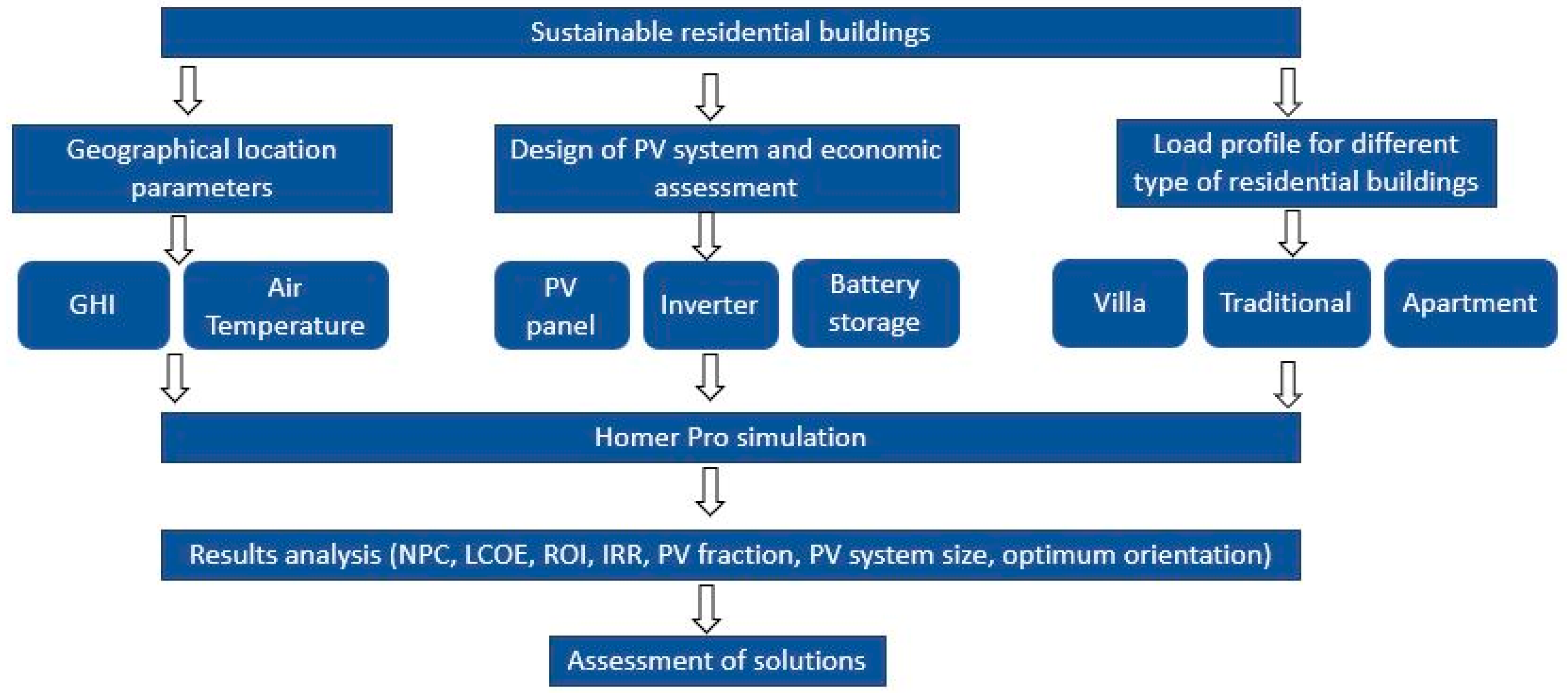
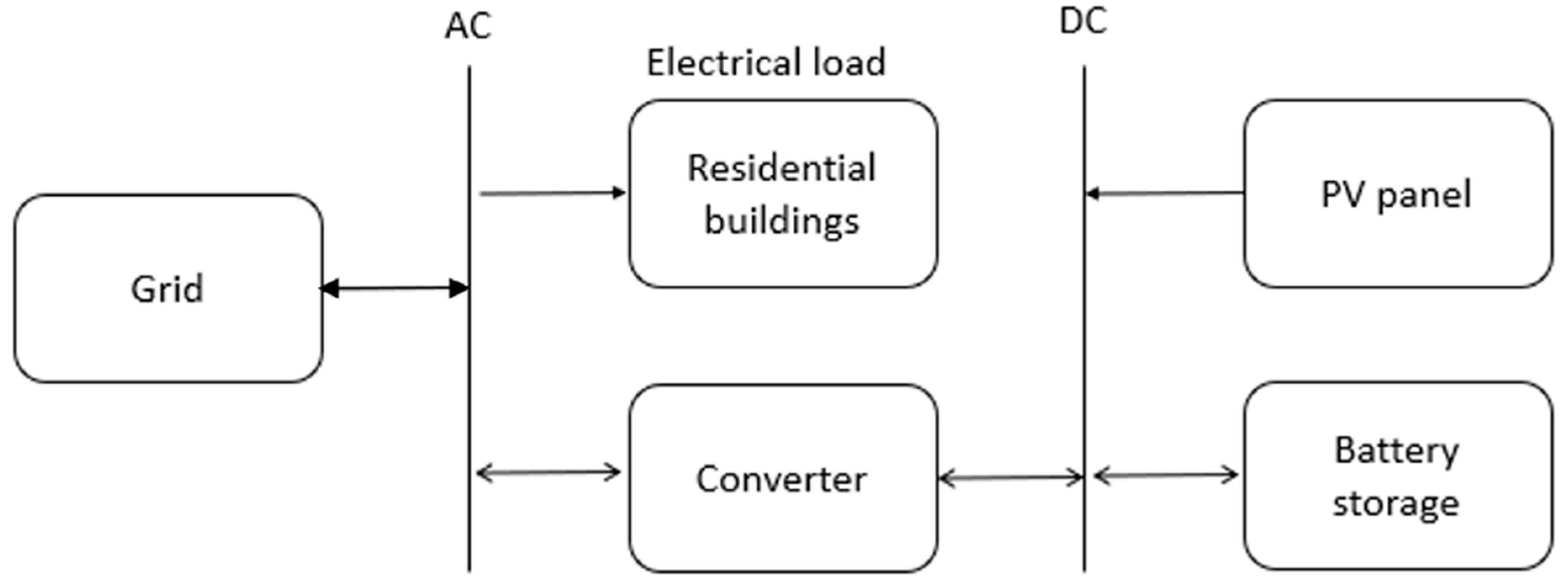
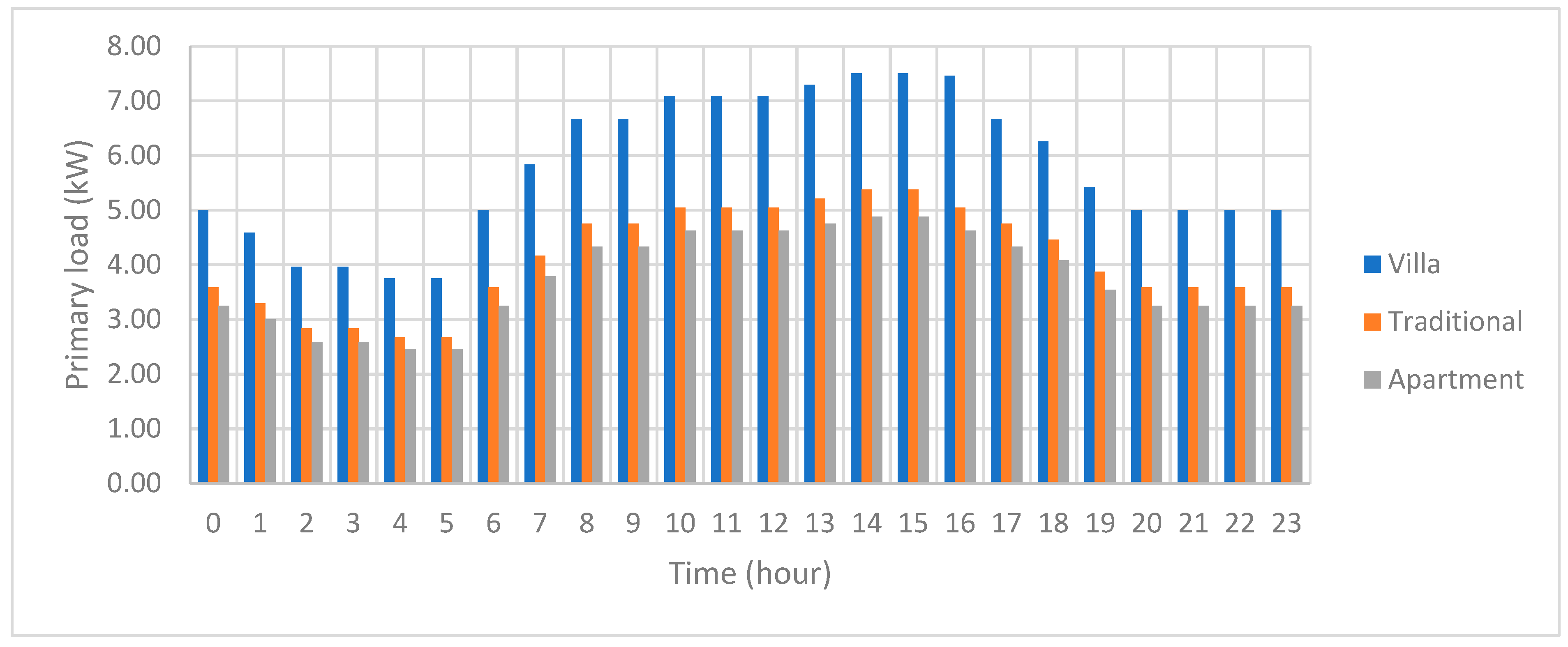
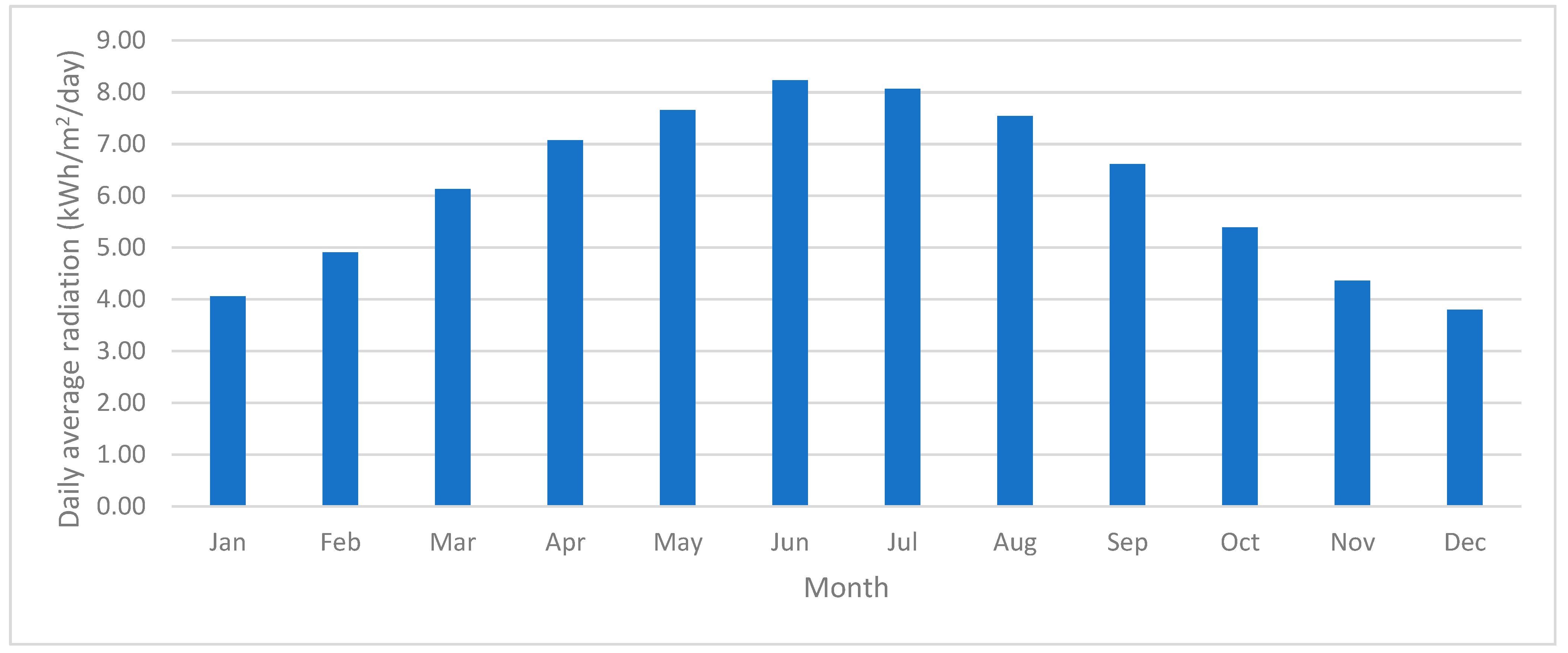

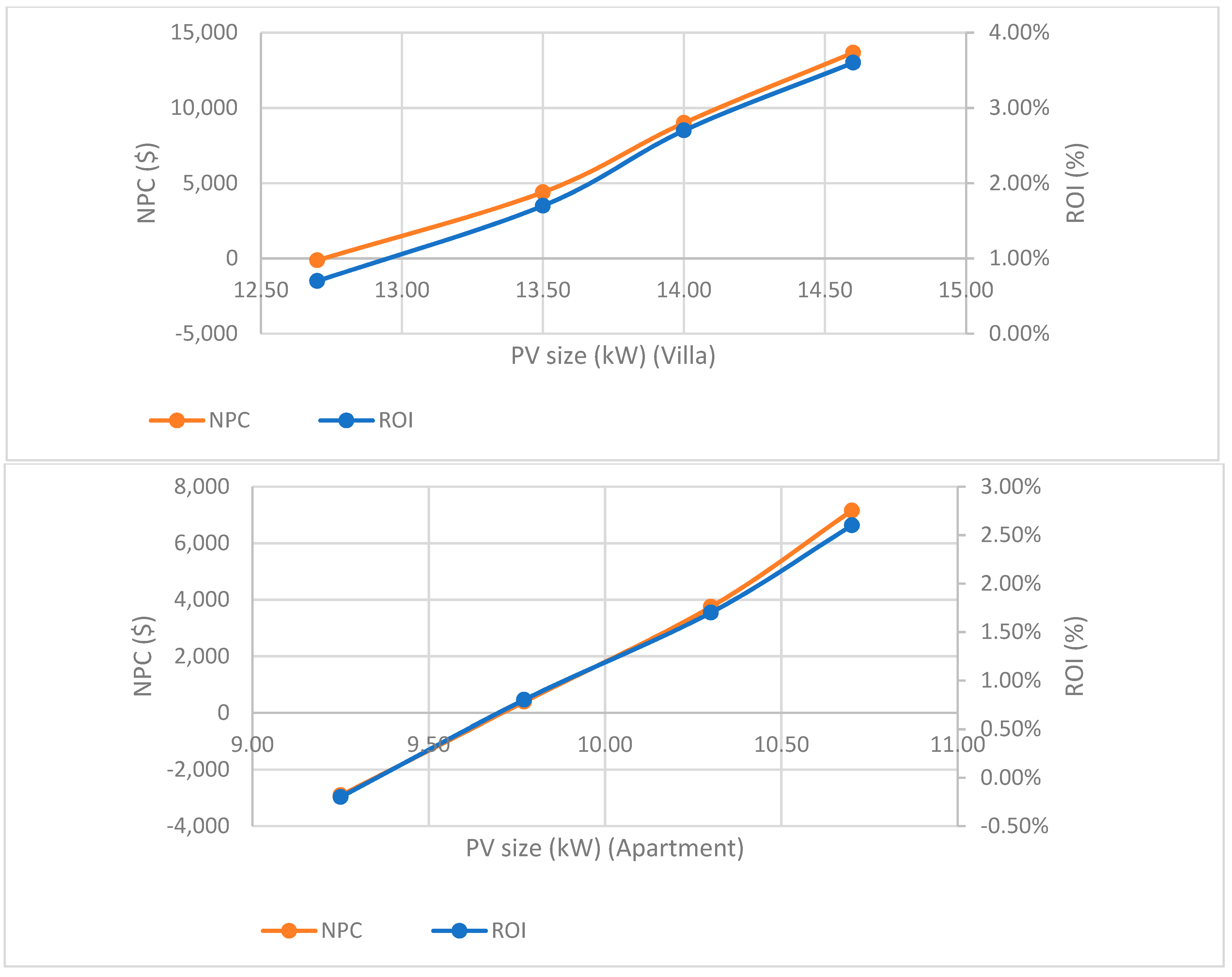
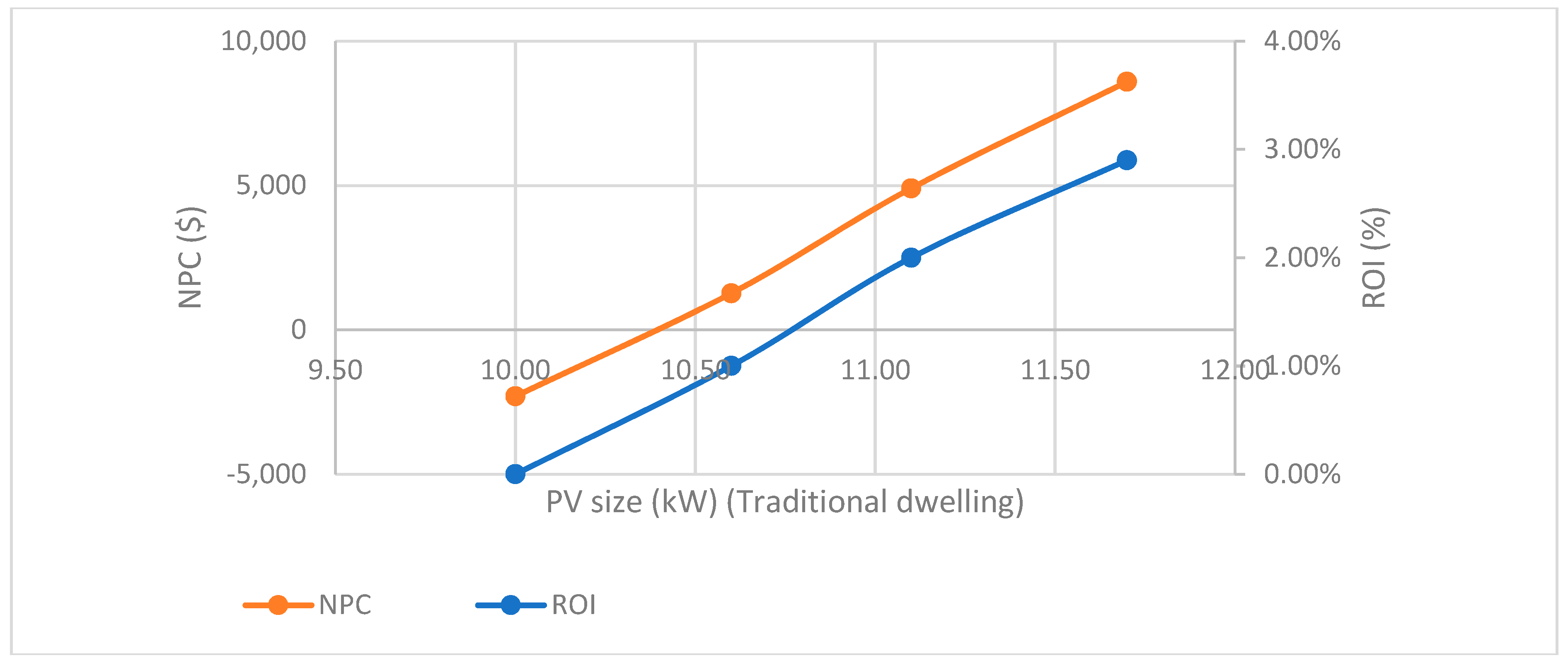
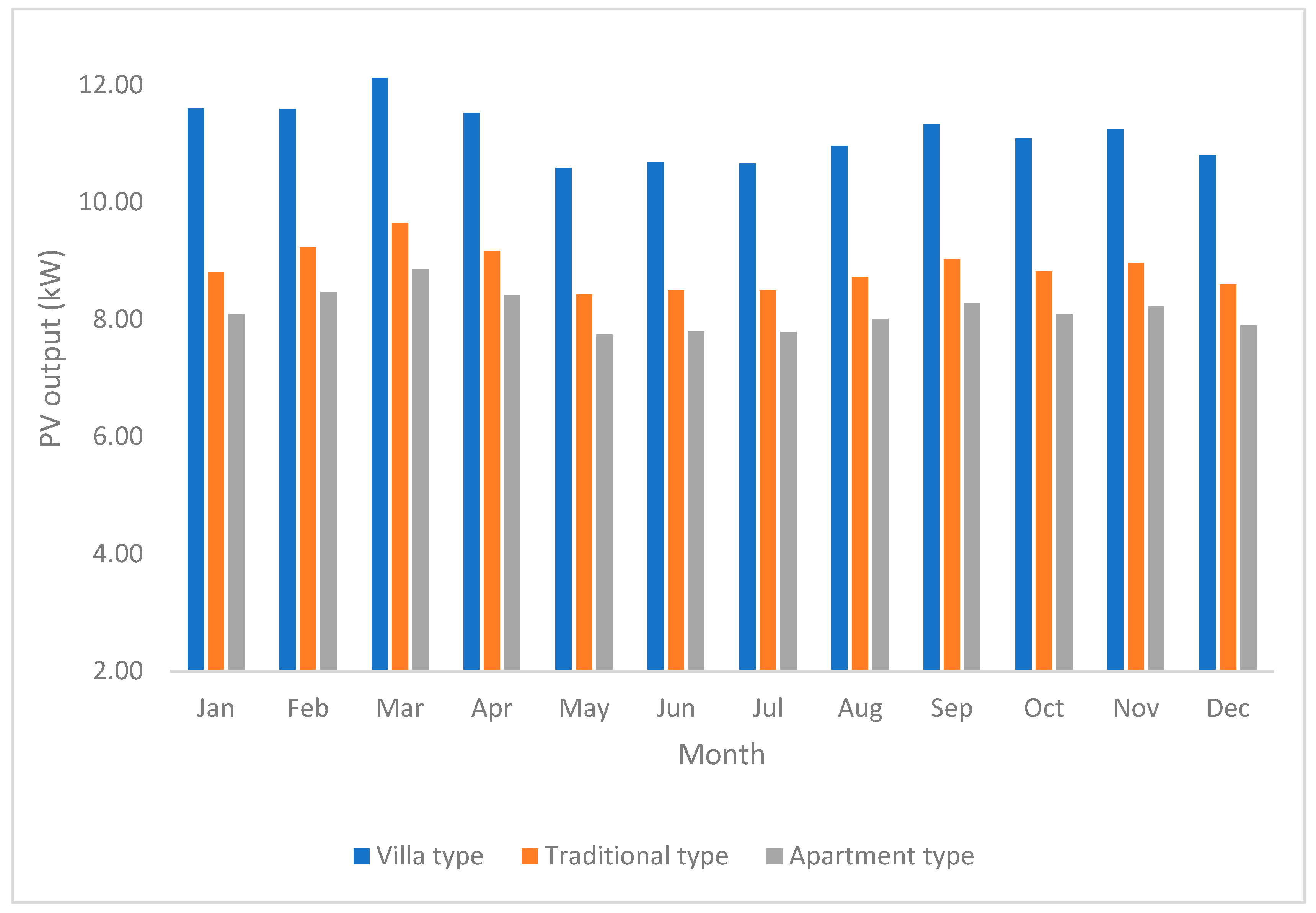
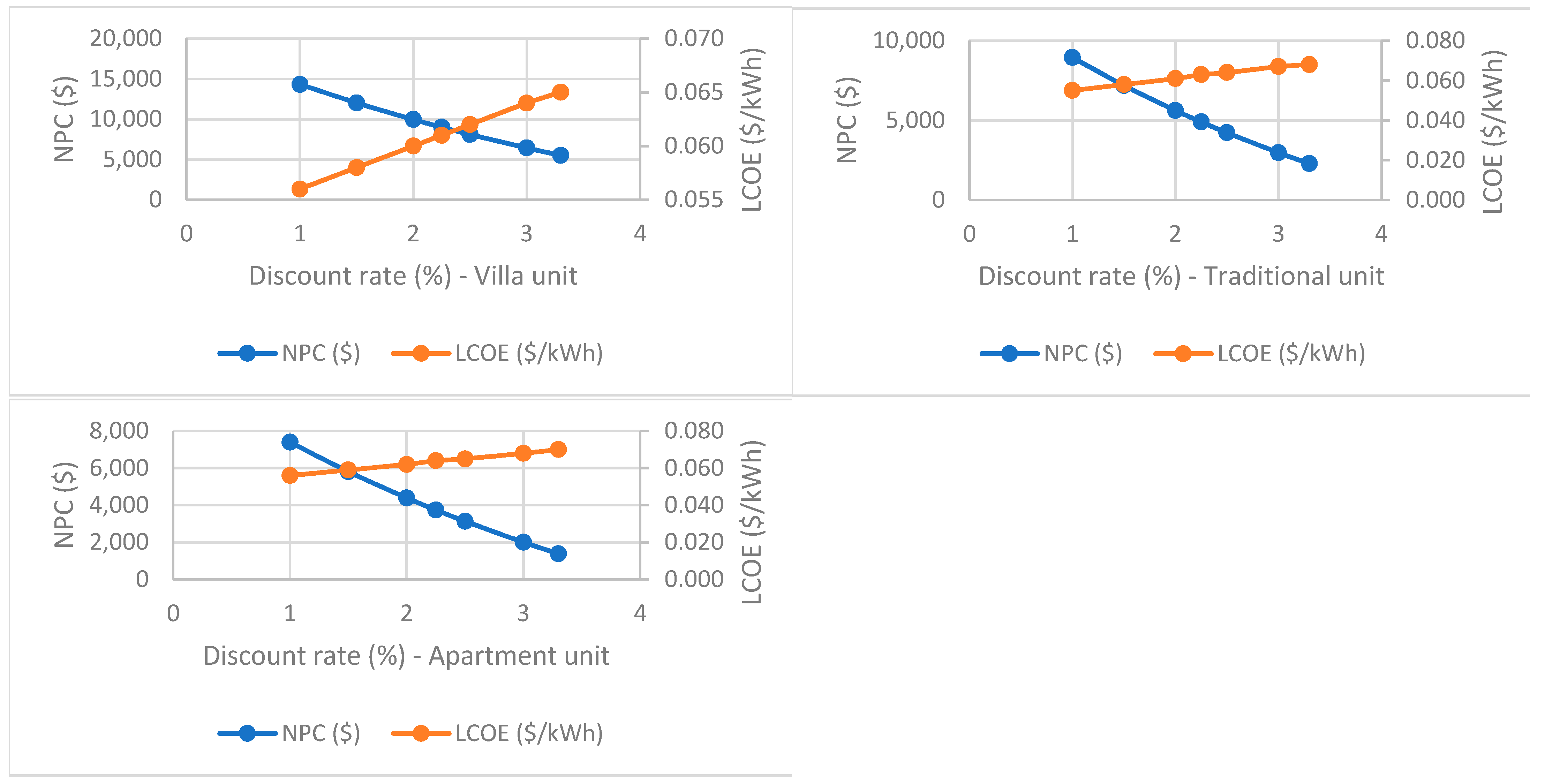
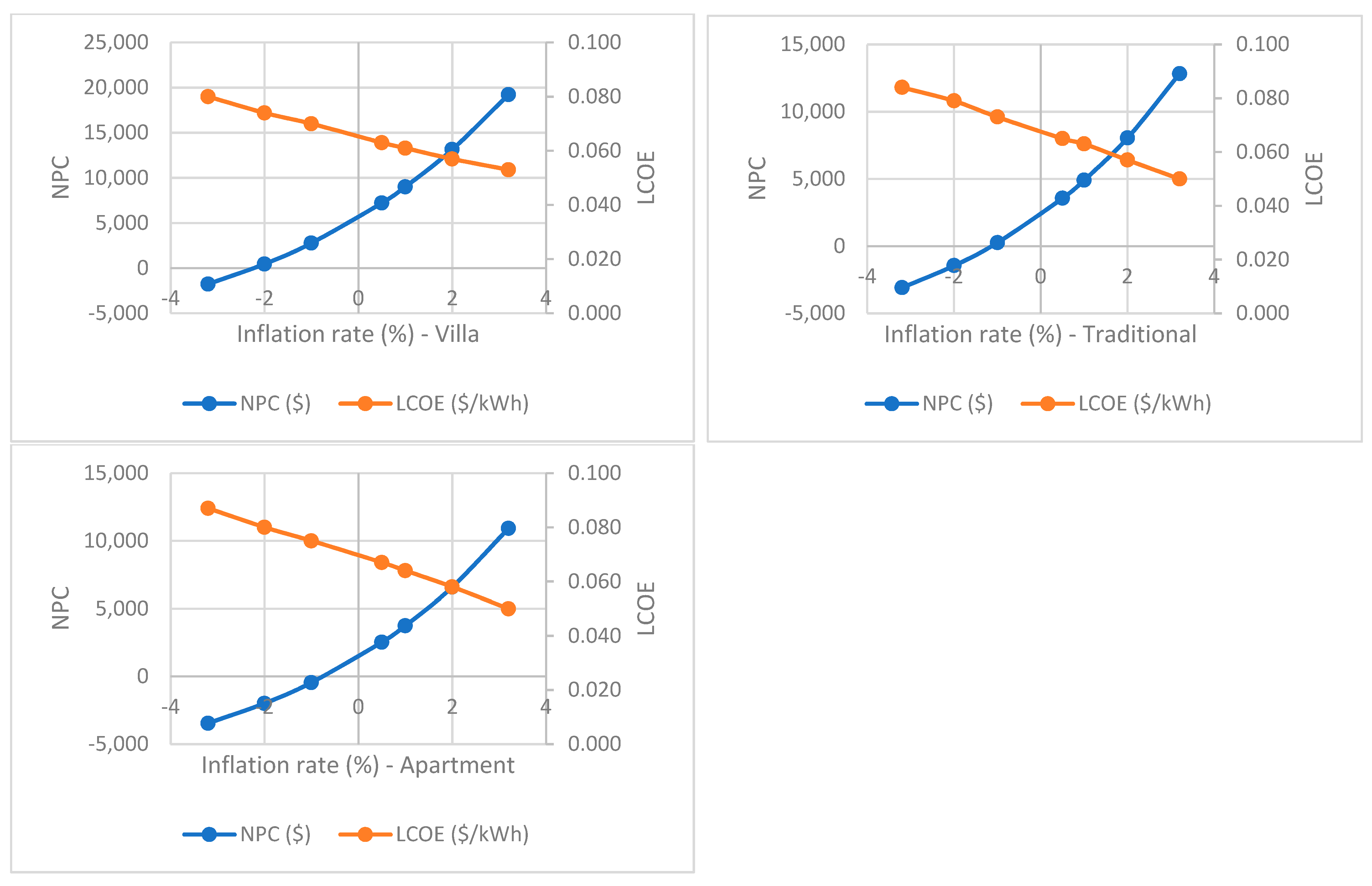
| Dwelling Type | No. of Occupants | Floor Area (m2) | Available Rooftop Area (m2) |
|---|---|---|---|
| Villa | Two parents with four children | (180–220) | (160–200) |
| Traditional | Two parents with two children | (170–200) | (155–185) |
| Apartment | Two parents with one child | (100–150) | (85–135) |
| Component | Parameter | Value | Purpose | Source |
|---|---|---|---|---|
| Grid | Grid power price for residential consumption up to 6000 kWh | 0.06 $/kWh (incl. 15% VAT) | [46] | |
| Grid power price for residential consumption over 6000 kWh | 0.09 $/kWh (incl. 15% VAT) | |||
| Grid power sellback | 0.02 $/kWh | Tariff for renewable resources | [47] | |
| PV | Capital cost/kW | $1200 | PV panel selection: Trina solar due to its common usage | [45] |
| Operation and maintenance cost/kW | 10 ($/year) | |||
| Lifetime | 25 years | |||
| Battery storage | Capital cost/unit | $4800 | “SonnenBatterie” | HOMER Pro library |
| Replacement cost | $7946 | |||
| Lifetime | 10 years |
| Economic Parameter | Electricity Tariff ($/Kwh) | |||||||||||
|---|---|---|---|---|---|---|---|---|---|---|---|---|
| 0.06 | 0.07 | 0.08 | 0.09 | |||||||||
| Villa | House | Apartment | Villa | House | Apartment | Villa | House | Apartment | Villa | House | Apartment | |
| NPC ($) | −119 | −2299 | −2911 | 4041 | 1265 | 386 | 9006 | 4903 | 3747 | 13699 | 8595 | 7153 |
| LCOE ($/kWh) | 0.055 | 0.059 | 0.060 | 0.058 | 0.061 | 0.062 | 0.061 | 0.063 | 0.064 | 0.063 | 0.064 | 0.065 |
| ROI (%) | 0.7 | 0.0 | −0.2 | 1.7 | 1.0 | 0.0 | 2.7 | 2.0 | 1.7 | 3.6 | 2.9 | 2.6 |
| IRR (%) | 1.2 | 0.1 | 0.0 | 2.9 | 1.8 | 1.4 | 4.4 | 3.3 | 3.0 | 5.7 | 4.7 | 4.3 |
| DPBP (years) | Exceeds Project Life | 22.44 | 24.49 | 24.84 | 16.66 | 18.36 | 22.71 | 14.73 | 16.22 | 16.75 | ||
| Dwelling Type | Optimal PV Size (kW) | NPC ($) | ROI (%) |
|---|---|---|---|
| Villa | 14.0 | 9006 | 2.7 |
| Traditional | 11.1 | 4903 | 2.0 |
| Apartment | 10.3 | 3747 | 1.7 |
Publisher’s Note: MDPI stays neutral with regard to jurisdictional claims in published maps and institutional affiliations. |
© 2021 by the authors. Licensee MDPI, Basel, Switzerland. This article is an open access article distributed under the terms and conditions of the Creative Commons Attribution (CC BY) license (https://creativecommons.org/licenses/by/4.0/).
Share and Cite
Alqahtani, N.; Balta-Ozkan, N. Assessment of Rooftop Solar Power Generation to Meet Residential Loads in the City of Neom, Saudi Arabia. Energies 2021, 14, 3805. https://doi.org/10.3390/en14133805
Alqahtani N, Balta-Ozkan N. Assessment of Rooftop Solar Power Generation to Meet Residential Loads in the City of Neom, Saudi Arabia. Energies. 2021; 14(13):3805. https://doi.org/10.3390/en14133805
Chicago/Turabian StyleAlqahtani, Nasser, and Nazmiye Balta-Ozkan. 2021. "Assessment of Rooftop Solar Power Generation to Meet Residential Loads in the City of Neom, Saudi Arabia" Energies 14, no. 13: 3805. https://doi.org/10.3390/en14133805
APA StyleAlqahtani, N., & Balta-Ozkan, N. (2021). Assessment of Rooftop Solar Power Generation to Meet Residential Loads in the City of Neom, Saudi Arabia. Energies, 14(13), 3805. https://doi.org/10.3390/en14133805






